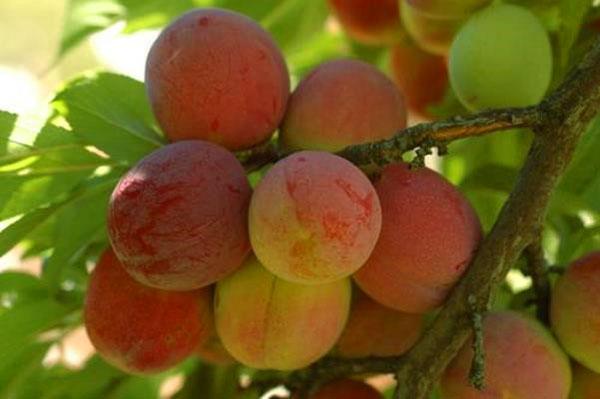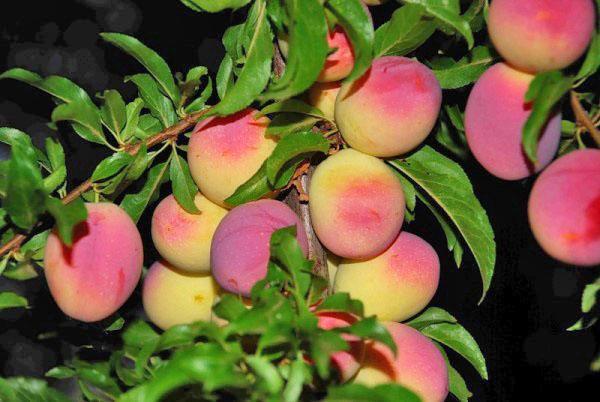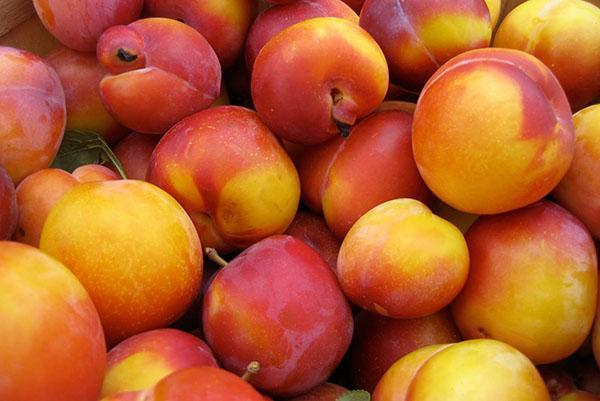Peculiarities of agricultural technology of plum varieties Peach
 Today, little or no previously known varieties of plums and other stone fruit crops are available to gardeners. It is not surprising that the owners of household plots are interested in the Peach plum, a description of the variety, a photo of the plant and its fruits, as well as the peculiarities of cultivation.
Today, little or no previously known varieties of plums and other stone fruit crops are available to gardeners. It is not surprising that the owners of household plots are interested in the Peach plum, a description of the variety, a photo of the plant and its fruits, as well as the peculiarities of cultivation.
First of all, this variety of domestic plum attracts attention with its large honey-colored fruits with a bright red-pink blush. The original appearance not only predetermined the name of the variety, but also became the cause of a common misconception. Many people mistakenly believe that the plant is a hybrid of a peach and a plum.
Stone fruit crops lend themselves well to interspecific crossing, yielding fertile offspring with certain parental traits. However, the peach plum only vaguely resembles a velvety southern fruit, as evidenced by a detailed description and photo of the plant.
Plum variety Peach

Now that selection has made great strides, this variety is rarely found in plantings. However, in Soviet times, the variety was recommended for cultivation in the southern regions, which included the republics of the Transcaucasia and the North Caucasus, Moldova, partly Ukraine, as well as the Kuban and Stavropol regions. To the north, due to the low winter hardiness, the plants froze out, not giving the desired harvest.
Subject to the rules of planting and care of the Peach plum forms medium or tall trees with a well-leafy crown of medium density. Young seedlings, in comparison with already fruiting plants, show high growth rates, which slows down by 5-7 years. It was at this time that the first ovary appears on the bouquet branches.
At first, fruit trees yield unstable crops, but gradually the indicators level out and increase. At the age of 15, early ripening plums provide up to 50 kg of massively ripening, almost non-falling fruits. Depending on the region and weather conditions, fruits are harvested from the second half of July to the second decade of August.
 Judging by the photo of the Peach Plum, the plant has large oval leaves with a blunt, barely distinguishable tip. The leaf blade, in contrast to peach, nectarine and apricot, is slightly pubescent, like the young shoots of this year, as well as dense short petioles on which the ovary is firmly held. The edges of the leaf are markedly serrated.
Judging by the photo of the Peach Plum, the plant has large oval leaves with a blunt, barely distinguishable tip. The leaf blade, in contrast to peach, nectarine and apricot, is slightly pubescent, like the young shoots of this year, as well as dense short petioles on which the ovary is firmly held. The edges of the leaf are markedly serrated.
According to the description of the variety and the photo of the Peach plum, it has large rounded or ovoid-oval fruits slightly squeezed at the top. On average, the weight of one plum with a thick, strong skin, on which there is an inconspicuous seam, is 45-50 grams. However, it is not uncommon for the weight of the fetus to reach 70 grams in warm years and with sufficient nutrition.
Plum color depends on the weather conditions. The main color of the skin covered with a bluish waxy bloom is greenish-yellow.But, if the fruit has been in the sun enough, a bright pink-red blush forms on its sides, capable of covering almost the entire surface.
The ripe, ready-to-pick plum has firm, juicy flesh with a beautiful golden hue. The stone is small, flattened, easily detached, which, together with decent taste, speaks of the value of the variety. Fragrant sweet and sour plums can be successfully used both fresh and as a raw material for making jam, jam, compotes and other culinary products.
Due to the dense skin and mass ripening of plums, the Peach variety is easily transported and stored for a short time. The only drawback of the culture is its low winter hardiness, which does not allow growing the variety without risk even in the Central Black Earth Region.
Plum Peach Michurina
 Obviously, knowing about the ruddy southern plum and wanting to get a more cold-resistant variety, in 1904 I. Michurin began to create a similar variety of his own selection. As a basis, the scientist took a bone of a white plum, brought from the Samara farm of Reshetnikov. When the seedling bloomed, it was pollinated with the American variety Washington. The plant, named Michurin's Peach Plum, first bore fruit only in 1921.
Obviously, knowing about the ruddy southern plum and wanting to get a more cold-resistant variety, in 1904 I. Michurin began to create a similar variety of his own selection. As a basis, the scientist took a bone of a white plum, brought from the Samara farm of Reshetnikov. When the seedling bloomed, it was pollinated with the American variety Washington. The plant, named Michurin's Peach Plum, first bore fruit only in 1921.
The fruits of this culture are round or rounded-oval in shape. On a yellow skin with a dull greenish tint, you can see:
- shallow seam;
- a bluish waxy bloom that is easily erased when the plum gets into the hands or in contact with other fruits;
- pale, blurred blush of a reddish hue, less pronounced than that of the Peach plum variety.
The weight of the more harmful plum is 35–45 grams. Under the thin skin there is a sweet, juicy pulp of excellent taste, containing up to 11% sugar and very few acids. Basically, the fruits are used for food fresh, but they can become an excellent raw material for processing into culinary dishes and for fruit preservation.
In comparison with the southern congener, Michurinskaya plum has a lower yield. From an adult tree with a dense crown and a height of 3-4 meters, you can collect up to 15 kg of sweet dessert fruits. At the same time, the fruiting period begins 1–2 years later, and the harvest is not in July, but in August and early September.
 Despite the existing disadvantages of the plum, Peach Michurina is more winter-hardy and can consistently bear fruit in the Voronezh, Kursk, Belgorod regions and further south. A little further north, for example, in the Tambov region, the plant often does not mature and young shoots freeze out, which reduces the yield and calls into question the advisability of growing the variety.
Despite the existing disadvantages of the plum, Peach Michurina is more winter-hardy and can consistently bear fruit in the Voronezh, Kursk, Belgorod regions and further south. A little further north, for example, in the Tambov region, the plant often does not mature and young shoots freeze out, which reduces the yield and calls into question the advisability of growing the variety.
Features of planting and caring for Peach plum
 Like all stone fruit crops, plums need proper care, which begins with choosing a place for planting.
Like all stone fruit crops, plums need proper care, which begins with choosing a place for planting.
For quick rooting and successful growth, find a sunny, wind-protected area with light fertile soil. It should be borne in mind that a plant that is well related to watering does not tolerate the proximity of groundwater.
 However, the biggest drawback of this fruit crop is its low resistance to cold. First of all, young seedlings suffer from frost, which should be covered for the winter. It is good if the tree has natural protection from the wind, such as a building wall, fence or hedge. A photo of Peach plum and a description of the variety say that the ovary is formed on small bouquet branches. If the plant winters well, in spring it will delight with lush flowering.
However, the biggest drawback of this fruit crop is its low resistance to cold. First of all, young seedlings suffer from frost, which should be covered for the winter. It is good if the tree has natural protection from the wind, such as a building wall, fence or hedge. A photo of Peach plum and a description of the variety say that the ovary is formed on small bouquet branches. If the plant winters well, in spring it will delight with lush flowering.
But you should not wait for a bountiful harvest, unless you take care of planting varieties that can pollinate these fruit trees in advance. The pollinators of the Peach plum variety include the varieties of Renkloda and Vengerka that bloom simultaneously with it, as well as the variety Anna Shpet and Mirabelle Nancy. Pollinating trees should be nearby, within reach for beescarrying pollen from one plant to another.